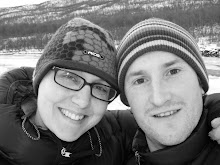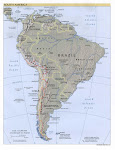The road over the high Andes was of course high and quite difficult. It could also have been avoided had we not wanted such an outlandish detour for our first big milestone on the trip.
To help make the occassion pass with as little worry as possible, Easter Island was booked up and off we went. Santiago being very smoggy and uninteresting deserves little mention other than having an amazing view from the aeroplane once it reached above cloud level.


Five hours West (by plane) from South America and you reach Easter Island (Rapa Nui), the most isolated inhabited place in the world. From here it is another 6 hours to Tahiti, 5 hours to Hawai'i, or 5 hours back to Santiago. Such an islolated place is bound to develop an interesting history but for descendants of other Polynesians, Rapa Nui managed to outdo them all by building giant monolithic figures to worship.




Hundreds of years later people from all over the world (but mainly from Japan) would come to visit these giants. 
During this lovely break we had the luxury of hiring a car for a couple of days to help us rest the cycling muscles. Ian first thought the jeep was a birthday present but soon realised it would be difficult to get it home.

To make sure Ian didn't forget he was getting old, Gemma found some candles to light for every meal he wanted. Ian made sure he didn't forget he was still a big child by monkeying around with the candles. To make sure nobody else found out he also ran around shouting childish obsenities at people - pooballs!


After 6 days on the island we had found ourselves out of places to visit. We packed up, still amazed and in wonder, and headed back to Chile to find the bikes. 




The birdman cult eventually took over the island and led to crazies jumping off cliffs to catch eggs. The carvings on this rock look nothing like the giant pile of bones at the bottom of the cliff.

Once we get over our jolly we wil be back on the bikes and we will be starting again from Mendoza (Argentina) heading north to Villa Union.
Never mind thousands of kms or miles, Ian was turning 30!
To help make the occassion pass with as little worry as possible, Easter Island was booked up and off we went. Santiago being very smoggy and uninteresting deserves little mention other than having an amazing view from the aeroplane once it reached above cloud level.


Five hours West (by plane) from South America and you reach Easter Island (Rapa Nui), the most isolated inhabited place in the world. From here it is another 6 hours to Tahiti, 5 hours to Hawai'i, or 5 hours back to Santiago. Such an islolated place is bound to develop an interesting history but for descendants of other Polynesians, Rapa Nui managed to outdo them all by building giant monolithic figures to worship.




Hundreds of years later people from all over the world (but mainly from Japan) would come to visit these giants.

During this lovely break we had the luxury of hiring a car for a couple of days to help us rest the cycling muscles. Ian first thought the jeep was a birthday present but soon realised it would be difficult to get it home.

To make sure Ian didn't forget he was getting old, Gemma found some candles to light for every meal he wanted. Ian made sure he didn't forget he was still a big child by monkeying around with the candles. To make sure nobody else found out he also ran around shouting childish obsenities at people - pooballs!


After 6 days on the island we had found ourselves out of places to visit. We packed up, still amazed and in wonder, and headed back to Chile to find the bikes.
It's difficult to explain the wonder of the Moai in words, the pictures are better but still nowhere near as amazing as seeing them up close...





The birdman cult eventually took over the island and led to crazies jumping off cliffs to catch eggs. The carvings on this rock look nothing like the giant pile of bones at the bottom of the cliff.

Once we get over our jolly we wil be back on the bikes and we will be starting again from Mendoza (Argentina) heading north to Villa Union.
We will update again soon, love to everybody back at home,
Ian (old) and Gem xx




























